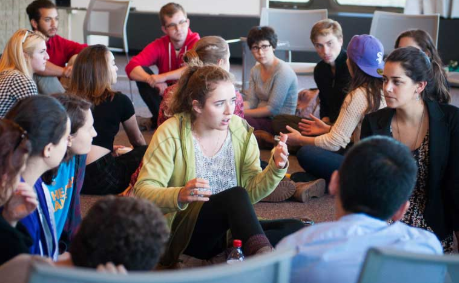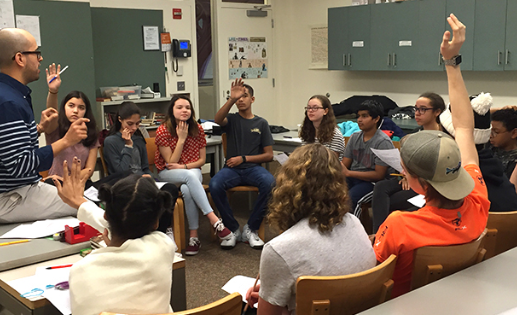What is a Difficult Class Discussion?
A difficult class discussion may come up in any subject, but particularly in classes where social and political issues are a part of the curriculum. These discussions can include topics such as LGBTQ+ rights, gender equality (e.g., wage gap, sexual assault) racism and racial justice (e.g., police brutality) indigenous issues (e.g., residential schools), issues of bodily autonomy (e.g., euthanasia, abortion, access to healthcare), mental health (e.g., suicide, addiction), disability, religion (e.g., separation of church and state), the environment (e.g., climate change, pipelines) and many other topics.

Establishing Respectful Guidelines Before Getting Started:
To create an environment where students feel safe and empowered, respectful guidelines must be established at the beginning of a course or school year.
Difficult topics may evoke strong emotions in students as they potentially can relate to personal and/or lived experiences rather than being simply theoretical thought experiments.
The idea that students’ human rights are up for debate is not good practice. For example, a classroom discussion on whether or not same gender marriage should be legal or whether religious headdress should be allowed in the workplace may seem like a good way for students to flex their debating and critical thinking skills, but it in reality the feeling of safety and being a valued member of the community for some becomes threatened.
Establishing your classroom as a place where people feel free to express themselves without fear and danger is crucial before attempting difficult classroom discussions.
BEFORE:
Before conducting a class discussion on a potentially challenging or controversial topic, consider possible sources of students’ views. Acknowledge the value of your students’ knowledge and experience, and keep in mind that these topics may not be theoretical discussion topics for some students, but lived experiences.
Be prepared to confront your own biases or prejudices related to the discussion topic.
Be prepared to learn new things from students’ perspectives.
Consider sharing with the class what perspective, bias, and emotional and intellectual growth you come to this subject with yourself. This may prompt students to question their own biases, as well as allowing students to hold you accountable to leaning too strongly on said biases. SEE BIAS SECTION

When introducing the discussion, lead with your goals.
-
What do you want students to get out of this discussion?
-
Why is this an important discussion for the class to be having?
-
What standards of behaviour do you expect your students to follow in this discussion?
If possible, provide students with pre-discussion material/reading, in order to contextualize the topic, allow students to reflect on the topic, and speak from an informed perspective. Use different strategies that encourage all students to feel comfortable sharing their ideas and opinions; small group discussion, the right to pass, partner discussion, independent work where opinions are vetted in writing first.
THINGS TO CONSIDER ESTABLISHING DISCUSSION GUIDELINES:
(Co-creating guidelines with your students can be a valuable experience if it can be guided to include essential criteria.
Below are some widely used respectful discussion criteria.)
-
One speaker at a time, everyone else listens actively and respectfully without interruption.
-
Use “I” statements: “I think,” “I feel,” “I believe”.
-
Allow everyone an opportunity to speak.
-
Criticise ideas, not individuals or groups.
-
Refrain from making generalizations about individuals or groups of people.
-
Ask questions for clarification.
-
Assume the best of intentions from others.
-
Respect confidentiality. What is shared in this space stays here.
-
No name calling, slurs, swearing, or other hostile behaviour.
-
Don’t expect individuals to represent an entire group (i.e., race, ethnicity, religion, gender, class, status).
DURING:
It is essential that you actively moderate the discussion. Be prepared to prompt students as needed for elaboration, clarification, re-phrasing, and reminders of the guidelines.
Credit speaker by name when referring back to/summarizing points made.
Address the emotional and social difficulty of the discussion.
Correct gently, but do correct misinformation.
Point out: why this may be a difficult conversation for people?
Why do people feel so strongly?
Discuss why some discomfort is important for learning and expanding one’s perspective in difficult conversations.
Be prepared to defer the conversation, if it becomes too heated or off-topic.
Stay a neutral facilitator whenever possible.


